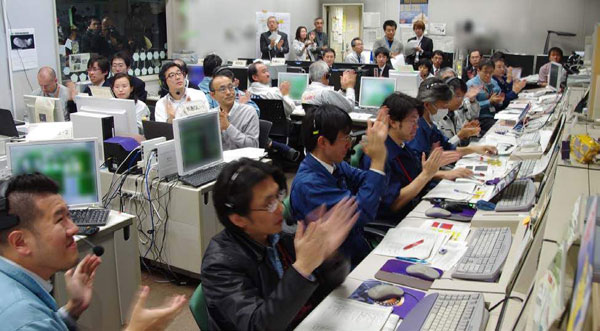Japan’s Akatsuki Reaches Venus . . . At Last
Engineers executed an innovative contingency plan to save the Akatsuki spacecraft and place it in orbit around our sister planet.
Triumph is never sweeter than when following defeat. On Sunday, December 6th, at 23:51 Universal Time, the Japanese Aerospace Exploration Agency's (JAXA) Venus Climate Orbiter Akatsuki burned four tiny reaction-control thrusters for more than 20 minutes to insert the spacecraft into Venusian orbit. The success came five years to the day after a main engine failure in 2010 caused the spacecraft to fly past Venus instead of going into orbit, leaving scientists and engineers to puzzle out a way to salvage the mission.

Elation in mission control at the Japanese Aerospace Exploration Agency following Akatsuki's orbital insertion.
JAXA
JAXA
Launched atop an H-IIA rocket from Tanegashima Space Center in Japan on May 20, 2010, Akatsuki (meaning "dawn" in Japanese) is JAXA's first mission to the planet Venus.

The Ultraviolet Imager aboard Akatsuki captured this image of Venus's swirling atmosphere on December 7th from an altitude of 72,000 kilometers.
JAXA
JAXA
The six instruments aboard the Akatsuki spacecraft will probe Venus’s atmosphere, measuring its rotation and convection.Researchers also hope to detect evidence for Venusian lightning using a high-speed imager aboard the spacecraft. Viewing across radio, infrared, visible and ultraviolet wavelengths, the payload will also record heat radiated from the Venusian surface and may spot active volcanoes if they exist. A series of radio occultation experiments will also allow researchers to probe the depths of the Venusian atmosphere as the spacecraft makes successive passes behind the planet as seen from Earth.
In addition to the science payload, JAXA also teamed up with the Planetary Society to carry to Venus more than 260,000 people’s names and messages printed on aluminum plates aboard the spacecraft.
If At First You Don’t Succeed . . .

This diagram shows Akatsuki's hibernation orbit around the Sun (green) with respect to Earth's (blue) and Venus's (red) orbits, before its reunion with Venus on December 6, 2015.
JAXA
JAXA
The spacecraft ran into trouble on December 6, 2010, when its main engine failed to execute a planned 12-minute burn to enter orbit around Venus. The spacecraft emerged from radio blackout behind Venus in safe mode, having only burned its engines for 152 seconds before shutting down. Later telemetry analysis showed a pressure drop caused by a faulty check valve in the main engine, which resulted in burning an oxidizer-rich mixture beyond normal limits. The failure overheated and destroyed much of the main engine.
With its main means of propulsion ruined, Akatsuki flew past Venus and entered solar orbit, and scientists and engineers scrambled to recover the mission. They came up with an innovative solution: burn its four reaction control thrusters for over 20 minutes — much longer than before — at the next available opportunity to enter orbit around Venus. Engineers tested a series of shorter burns in 2011 to show that this attempt was indeed possible. The spacecraft was then placed in hibernation mode to extend its life.
A Space Milestone for JAXA

This diagram shows Akatsuki's current (green) and future (purple) orbits. The additional engine burn planned for spring 2016 will reduce the farthest distance of the spacecraft from Venus.
JAXA
JAXA
Akatsuki’s successful orbital insertion marks a milestone for JAXA: it’s the first time the space agency has put a spacecraft in orbit around another planet. In 2003 JAXA's first attempt, the Nozomi mission to Mars, failed to orbit achieve orbit. Another mission, a successful solar sail demonstrator named IKAROS that deployed along with Akatsuki, was a Venus flyby mission only. And JAXA’s Hayabusa 2 sample return mission flew by Earth just last week en route to asteroid 162173 Ryugu in July 2018.
The 2015 orbital insertion places Akatsuki in a slightly wider-ranging orbit than originally intended. The planned track would have carried the spacecraft around Venus every 30 hours, with a closest approach of 300 km. This week’s burn placed Akatsuki in a 13.6-day elliptical orbit that brings it as close as 400 km to the surface. Next March, JAXA is planning a series of engine burns that should shrink Akatsuki’s elliptical orbit to a period of 9 days.
A brief press release from JAXA today reports the burn went as planned, and the spacecraft is in good health and in its expected orbit.
Space is hard, and the successful recovery of the Akatsuki mission highlights the resourcefulness of JAXA engineers. Congrats to the team on a remarkable feat to contemplate this holiday season, as Venus shines high in the east of Earth’s dawn skies. Watch for some great science out of the Akatsuki mission to come in 2016.
No comments:
Post a Comment